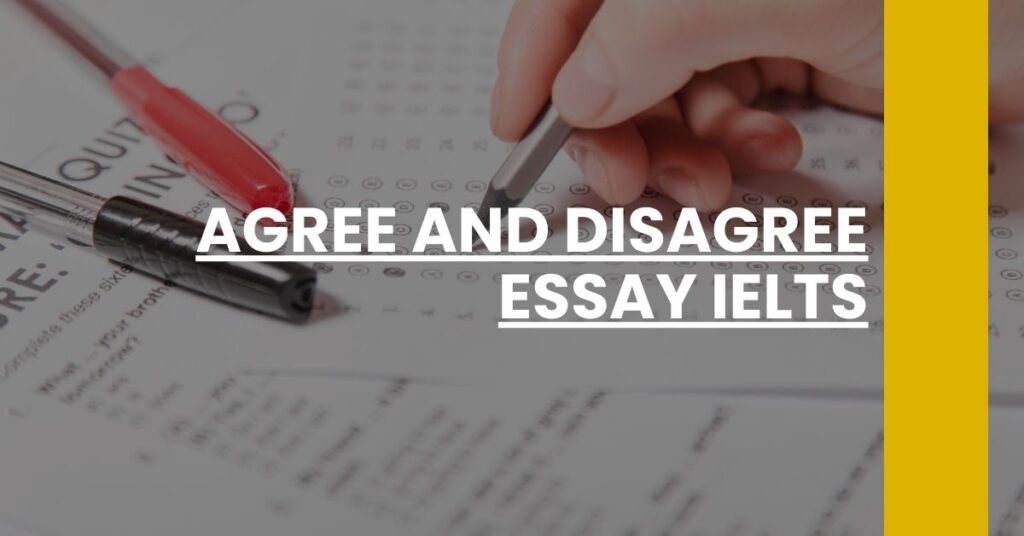Master the agree and disagree essay IELTS with our expert tips.
- Essay Structure for IELTS: Learn the key structure to articulate your position effectively.
- Argument Development Skills: Hone the ability to present compelling arguments and rebuttals.
- Scoring High in IELTS: Understand what examiners look for to score top marks in your essay.
Achieve excellence in your agree and disagree essay IELTS writing task.
Understanding the Agree or Disagree Essay
The agree or disagree essay is a staple of the IELTS Writing Task 2, a critical component of the exam that can significantly sway your overall score. As you approach this task, it’s crucial to appreciate that IELTS examiners aren’t just looking for your opinion. They’re evaluating your ability to articulate it clearly, logically, and persuasively. This essay format requires a measured response where you either side strongly with a viewpoint or present a balanced perspective, systematically supporting your standpoint with reasoned arguments and concrete examples.
To excel in crafting these essays, you need not only good grammar and vocabulary but also the skill to construct a cohesively argued piece that reflects critical thinking—qualities that can uplift your essay from mediocre to impressive.
What are Examiners Looking For?
IELTS examiners have a checklist of criteria:
- Task Response: How well you present your arguments and ideas in support of your stance.
- Coherence and Cohesion: The clarity and fluency of your essay, as well as its logical structure.
- Lexical Resource: Your use of vocabulary – it should be varied and appropriate.
- Grammatical Range and Accuracy: The variety and accuracy of your grammar.
Mastering the agree or disagree essay isn’t merely about choosing a side. It entails floorless argumentation that convinces the reader of the soundness of your position. It’s this prowess in making a clear, coherent argument that could propel you to a band score of 7 or above.
Analyzing the Essay Prompt
Before you even begin to plan your essay, it’s imperative to decipher the prompt meticulously. Every word in it matters and your understanding of the task dictates your response.
Dissecting the Task
Take the time to analyze the essay prompt with these steps:
- Identify the main topic: What is the prompt really about? Is it education, technology, environment, or another subject?
- Understand the question type: Is it asking you to agree or disagree?
- Decipher the specifics: Are there any particular aspects or angles you need to focus on?
Here’s an example:
Do you agree or disagree with the following statement? Parents are the best teachers.
- Main topic: The roles of parents.
- Question type: It’s a direct agree/disagree question.
- Specifics: Focus on parents’ roles as teachers.
What’s Your Stance?
As you ponder the essay prompt, quickly decide if you’ll agree or disagree, as this will shape every part of your essay. Stick with your gut feeling—it’s usually the viewpoint you can argue for most effectively.
Structuring Your Essay
A well-structured essay guides the reader smoothly through your argument, like a roadmap spotlighting the scenic points along a journey. The clarity of this journey is fundamental to your success.
Crafting an Engaging Introduction
First, anchor your essay with an introduction that sets the stage:
- Hook the Reader: Start with a statement or a question that piques interest.
- Present Your Thesis: Clearly state your main argument – the heart of your essay.
Example of an introduction: “From the first word to life’s complex lessons, parents imprint their wisdom on their children’s hearts. I firmly believe parents do, indeed, make the best teachers.”
Developing Body Paragraphs
Your essay’s body is where the meat of your argument lies – each paragraph should unpack a single point in favor of your stance.
- First key idea: Present a reason for your agreement or disagreement.
- Second key idea: Support the idea with examples, facts, or personal experiences.
- Expound with Depth: Delve into why this point bolsters your thesis.
Illustration of a body paragraph: “Parents instill morality and values from infancy, lessons often learned through observation and imitation. One might consider the parent-child bond, a blend of inherent trust and influential engagement, as the ideal medium for life lessons.”
Adding Cohesion with Connectives
Transition words are your ally in connecting sentences and paragraphs seamlessly. Words such as furthermore, however, and thus ensure your argument flows effortlessly like a river running through a valley.
Refuting Opposing Views
A paragraph dedicated to countering the opposition can strengthen your position. Recognize a compelling contrary argument and then dismantle it.
- Acknowledge: Begin by fairly presenting the opposing view.
- Rebuttal: Follow with a clear and reasoned refutation.
Example of refuting a viewpoint: “While some argue that formal educators shape learners more significantly, this ignores the pivotal role parents play in early character formation.”
Writing a Persuasive Conclusion
The conclusion is your final opportunity to leave an indelible mark on the reader. Recap the main points and reiterate your thesis, affirming the thoroughness of your argument.
- Summarize Key Points: Briefly recall the reasons supporting your stance.
- Restate Your Thesis: Reinforce the stance you’ve presented with confidence.
For instance: “In closing, parents’ continuous influence and unwavering guidance elevate them to more than mere instructors – they are indeed the primary, and perhaps the best, teachers in any child’s life.”
With the proper structure in place, the agree and disagree essay becomes a medium for you to showcase your critical thinking, and command over language—a testament to your readiness to communicate effectively in an English-speaking context.
Generating Ideas and Arguments
When approaching your agree and disagree essay IELTS, generating potent ideas and constructing cogent arguments are essential. These elements form the backbone of your response and are indispensable in demonstrating value to the examiner.
Choosing a Side
Initially, decide whether you agree or disagree with the statement. It’s important to pick the side you genuinely believe in or the one you feel you can argue most convincingly. Remember:
- Clarity of Position: Your stance should be unmistakably clear and explicitly stated.
- Supporting Ideas: Develop several supporting points that will form the basis of your individual body paragraphs.
Brainstorming Effectively
Follow these steps to brainstorm effectively and fill your idea arsenal:
- Take Time to Reflect: Give yourself a few minutes to think over the topic and its implications.
- List Key Points: Jot down all the ideas that come to mind without censoring them initially.
- Select the Strongest Points: Choose ideas that you can support with tangible examples or evidence.
Organizing Your Thoughts
Once you have your ideas:
- Categorize Them: Group your ideas by similarity or relevance.
- Arrange Logically: Sequence your arguments from strongest to weakest, or vice versa, to maintain reader engagement.
- Connect the Dots: Ensure that there is a logical progression of ideas from one paragraph to the next.
This organization will not only help you while writing but also ensure that the reader can follow your reasoning without getting lost.
Refining the Arguments
To refine your ideas:
- Use Specific Examples: Concrete examples make your essay more convincing. Consider drawing from current events, historical evidence, or personal experience.
- Develop Each Point: Don’t just state an idea; expand on it thoroughly to demonstrate your understanding of the topic.
By meticulously crafting each point, you ensure that your essay presents a balanced and well-thought response to the prompt.
Sample Agree or Disagree Essays
To enhance your understanding of an agree and disagree essay for IELTS, dissecting sample essays can be incredibly beneficial. Examine a strong sample and note how the writer:
- Introduces their Argument: Pay attention to the clear thesis statement.
- Structures their Essay: Observe the logical flow from the introduction to the concluding paragraph.
- Supports Their Points: Look at the evidence and examples given.
You can also learn from the comments of IELTS examiners and teachers, where they provide insights about what makes an essay effective or areas that need improvement.
Polishing Your Essay
Polishing your essay is like refining a precious gem—the more effort you put into it, the brighter it will shine.
- Proofreading: Every word counts. Review your essay for grammatical errors, typos, and punctuation mistakes.
- Checking for Cohesion and Coherence: Assess how smoothly your essay flows. Could a reader jump in at any paragraph and still understand your argument?
- Revising for Clarity: Ensure that every sentence delivers its message effectively. Trim any unnecessary words and clarify complex ideas.
A well-polished essay signals to the IELTS examiner that you take the task seriously and that you’re capable of presenting professional, high-quality work.
Common Mistakes to Avoid
In your journey to craft a high-scoring agree and disagree essay IELTS write-up, steering clear of common pitfalls is just as critical as following best practices.
- Over-Generalization: Be meticulous. Avoid broad statements that you can’t support with specific evidence.
- Repetition: It’s tedious and diminishes the impact of your arguments. Make each point once, convincingly.
- Ignoring the Opposite Side: Even if you have a strong opinion, acknowledging the counter-argument can add depth to your essay.
- Straying off Topic: Stick firmly to the issue at hand. Tangential thoughts can dilute the persuasiveness of your argument.
These mistakes can be the difference between an essay that soars and one that stumbles. Remain vigilant and review your work with an objective eye.
Master agree and disagree essay IELTS writing skills with effective strategies, ensuring exam success with structured argumentation techniques.

